Like a silk worm that has to walk on the ground is a precious dialogue between the artist Matteo Valerio and Tessitura Luigi Bevilacqua, which takes place through an exhibition at the Spazio Legno & Legno of CREA Cantieri del Contemporaneo on Giudecca’s island, Venice. The art works reveal a long Venetian tradition made up of quilts dyed with cocciniglia, indigo, guado and robbia using ancient dyeing techniques, typical of Tessitura Luigi Bevilacqua, a historic craft founded in 1875. History and contemporaneity confront each other in unpublished works, in which canvas and painting merge with velvets, broccatelli and damasks.
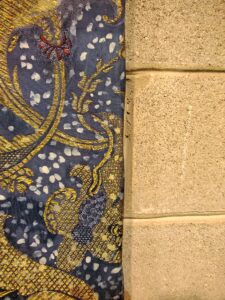
Matteo Valerio, Like a silk worm that has to walk on the ground, detail, installation view, courtesy Crea Cantieri del Contemporaneo
Tessitura Luigi Bevilacqua was founded after the emission of the 1806 Napoleonic decree that sanctioned the closure of the artisan guilds in the city of Venice. The invention of a new mechanized Jacquard loom contributed to mark the decline of the art of silk and velvet, which were only rediscovered and revalued after the middle of the century thanks to the development of the Arts and Crafts movement. It was in this context that Luigi Bevilacqua, with his partner, Giovanni Battista Gianoglio, decided to buy the old silk school in Fondamenta San Lorenzo in 1875 and make it the headquarters of the new textile factory.
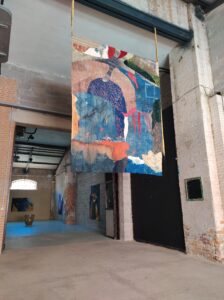
Matteo Valerio, Like a silk worm that has to walk on the ground, installation view, courtesy Crea Cantieri del Contemporaneo
Throughout the art history, but particularly in that of the 20th century, fabric has always been a material that artists have used to express important themes close to the body, the feminine and the identity. Matteo Valerio fits perfectly into this tradition, by narrating to us through his works, traits collected from the 1727 biography I demoni by Alvisa Zambelli. In a dossier, preserved in the fund of the Inquisition Tribunal in Venice, it is reported that this woman presented herself in the confessional to the parish priest of San Giacomo dell’Orio Church, Giovanni Maria Fattori. Alvisa Zambelli said she was a “daughter of the pious house of the Catechumens” and begged Fattori to free her from the continuous diabolic and sacral visions that continued to torment her against and which she had to fight.
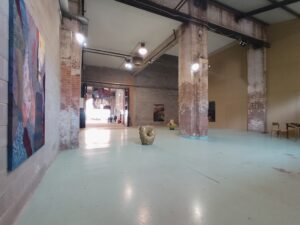
Matteo Valerio, Like a silk worm that has to walk on the ground, installation view, courtesy Crea Cantieri del Contemporaneo
Zambelli’s story is nothing but a pretext for investigating the duality of existence: light and shadow alternate in the paintings, shifting the observer’s gaze from moments of disquiet to moments of comfort. Valerio investigates the inner turmoil that haunts the human being revealing, through his works, the eternal struggle between hell and heaven. Like Alvisa Zambelli, the observer is invited to investigate himself in order to rediscover the fragile boundary that separates inner turmoil and joy.
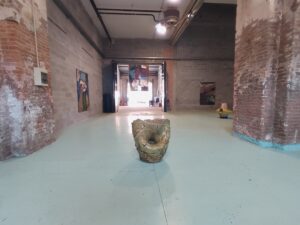
Matteo Valerio, Like a silk worm that has to walk on the ground, installation view, courtesy Crea Cantieri del Contemporaneo
The event is part of the PIC project – Patrimonio Industriale Contemporaneo (Contemporary Industrial Heritage) of Aiku- Arte Impresa Cultura, the centre of Ca’ Foscari University of Venice that aims to stimulate artists’ creativity and strategic innovation within companies. The programme aims to create a new form of storytelling and structure local, as well as artisan, industrial realities into culture-based business models.
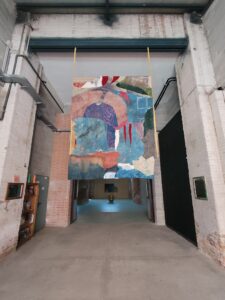
Matteo Valerio, Like a silk worm that has to walk on the ground, installation view, courtesy Crea Cantieri del Contemporaneo
The collaboration between Matteo Valerio and Tessiture Bevilacqua brings into play the thin line that differentiates work of art and craftsmanship by establishing a strong relationship between the two: the artist combines functional aspects with aesthetic and conceptual ones. The exhibition thus becomes the result of the Venetian tradition and Matteo Valerio’s study and practice. His constant research in the world of textile materials has, in fact, led him to a broad and profound understanding of the material’s potential.
Info:
Matteo Valerio, Like a silk worm that has to walk on the ground
16/03/2023 – 16/04/2023
Crea cantieri del contemporaneo
Venice, Sestiere Dorsoduro, (VE)
Curated by Pier Paolo Scelsi and Sabrina Comin
www.facebook.com/creacantieridelcontemporaneo
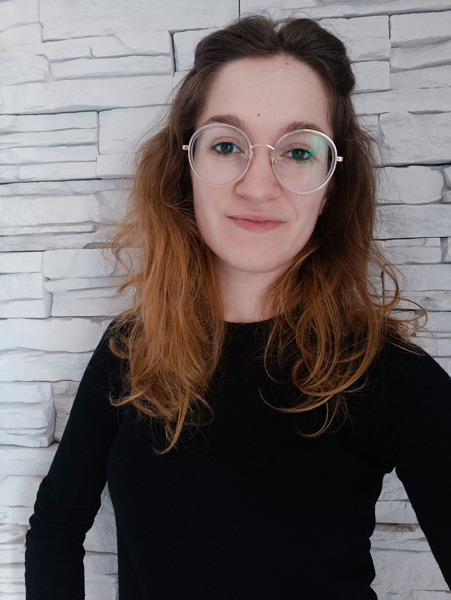
Graduated from the Academy of Fine Arts in Venice, she subsequently attended the School for Curatorial Studies in Venice. She writes about contemporary art with a particular eye towards emerging artists and experimental research projects.






NO COMMENT